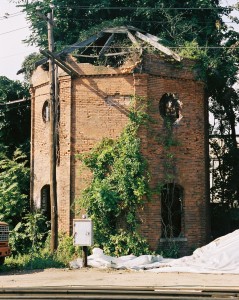Update Spring 2012:
For a number of years, the GPA has been working to preserve Guilford’s 19th-century railroad depot buildings and to identify development opportunities that would make the station a more attractive and integral part of our community. Recently we received permission from Amtrak to bring professionals to the site to measure, photograph, and collect data on the buildings; to develop a stabilization plan; and to evaluate restoration requirements.
Vines and debris have been cleared away from the octagonal brick water tower, and work will soon begin on the adjacent engine house. Local architect Randy Siress has generously volunteered his time for the project, working with board members William Mack, Russ Campaigne, and Joe Nugent. With donations from dozens of local citizens, the GPA has established a $25,000 fund earmarked for the eventual stabilization of these two endangered structures.
The GPA is also working with the Connecticut Department of Transportation to install a permanent historical display in the vestibule of the commuter rail station on the south side of the train tracks. The five panels–three pictorial friezes and two text panels–will tell the story of railroads in Guilford from the 1850s to the present. The exhibit has been designed by Dempsey Fitton, and researched and written by Ellie Green, Ellen Ebert, and Harry Haskell.
Ben Kuropat, who lives near the train station and is also an amateur photographer, took these marvelous photos on one of the cleanup days in March2012 (to see these on his Flickr page click here):
As described above, local architects William Mack and Randy Siress have donned hard hats, braved the elements, and volunteered hundreds of hours of time to create the beautiful drawings of the water tower that you can view here. Since the original plans for the structure no longer survive, this painstakingly researched documentation enables us for the first time to accurately envision the water tower in all its pristine splendor. From a practical standpoint, the drawings will serve as a blueprint for the building’s restoration and make reconstruction possible in the event that it collapses in a hurricane or other natural disaster.
Existing elevations (south and north)
Reconstructed elevations (south and north)
Existing elevations (west and east)
Reconstructed elevations (west and east)
Existing sections, Reconstructed sections
For more historical background about the train station buildings read the following article which appeared in the local media in February, 2005:
Preservation Alliance Seeks to Secure Historic Train-Station-Area Buildings
The Guilford Preservation Alliance has renewed talks with AMTRAK to save the surviving New Haven and New London Railroad maintenance buildings opposite the town’s train station. Once the engine repair shop and water tower for steam-driven locomotives, the structures are said to be rare or unique artifacts of a by-gone era. Built in the 1870s, they have stood unused since the introduction of diesel power in the 1930s. According to GPA President Preston Maynard, the Alliance is in discussions with Town officials, representatives of the state’s Department of Transportation (CONDOT) and the director of the Connecticut Trust for Historic Preservation in pursuit of public-private partnership to restore and reuse the one and one half-story brick engine house and distinctive octagonal water tower. The latter, also built of brick and in urgent need of stabilization, is believed to be the only one of its kind left in the state. Both structures are candidates for inclusion in the National Register of Historic Places and thus cannot be torn down. The GPA proposal contains potential economic benefits for the Town and other neighboring land owners-the town garage and Public Works Department stand nearby-as restoration and adaptive reuse of the two buildings would contribute significantly to Guilford ‘s identity as a tourist attraction. According to a recent study by Robert Santy, executive director of the Regional Growth Partnership (RGP), cultural tourism is one of the major growth industries in Connecticut. The buildings are currently owned by AMTRAK, which agreed several years ago to sell them to the Town for $1. Possible soil contamination at both sites derailed the negotiations at that time and the Town withdrew from the talks. Both state and federal funds, however, are available for soil-testing and clean-up through the RGP, of which Guilford is a member. This work cannot be done, the GPA says, unless the Town acquires the sites or allows the GPA to do so. Access to the buildings may require cooperation from adjacent land owners, including, AMTRAK, CONDOT and the Town of Guilford. Maynard says that the project is economically viable…. Once stabilized and restored, the engine house will be suitable for professional offices, cultural facilities or retail space, Maynard explained. The water tower, an architectural gem, would be a natural home for a tourist-information center. Both reuses would help to anchor the commercial redevelopment of the train station area and connect it touristically with the nearby state Whitfield Museum.








